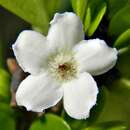Comprehensive Description
provided by North American Flora
Randia aculeata L. Sp. Pi. 1192. 1753
Randia mitis L. Sp. PL 1192. 1753. Randia lati folia Lam. Encvc. 3: 24. 1789. Gardenia aculeata Ait. Hort. Kew. 1: 295. 1789. Gardenia Randia Sw. Fl. Ind. Occ. 526. 1797. Gardenia Randia var. mitis Sw. Fl. Ind. Occ. 528. 1797.
Ra ndin obovata H. B. K. Nov. Gen. & Sp. 3: 409. 1819. Not R. obovata R. & P. 1799. Randia latifolia mitis DC. Prodr. 4: 385. 1830. Randia latifolia var. micrantha Schlecht. Linnaea 6: 723. 1831. Solena Randia I). Dietr. Syn. PL 1: 799. 1839. Randia aculeata /3 mitis Griseb. Fl. Brit. W. Ind. 318. 1861. Genipa aculeata Maza. Anal. Soc. Esp. Hist. Nat. 23: 288. 1894. M ussaenda rotundifolia Sesse & Moc. Fl. Mex. ed. 2. 59. 1894. Rondeletia spinosa K. Schumann, Bull. Herb. Boiss. 3: 620. 1895.
'Randia aculeata var. chiapasina Loesener, Verh. Bot. Ver. Prov. Brand. 65: 109. 1923. Randia spinosa Loesener, Verh. Bot. Ver. Prov. Brand. 65: 109. 1923. Not R. spinosa Poir. 1811.
A densely branched shrub 1-3 meters high, the branches reddish-brown or grayish, the branchlets stout, divaricate, glabrous or scaberulous when young, usually bearing at the apex 2 stout, ascending or divaricate spines 0.5-1.5 cm. long, sometimes unarmed, the leaves mostly clustered at the ends of the branchlets or on very short lateral spurs; stipules 2 mm. long or shorter, ovate-deltoid, usually acuminate, glabrous or scaberulous outside, pilose within at the base; petioles very short or obsolete, usually marginate to the base; leaf-blades very variable in shape and size, mostly obovate or obovate-orbicular, often orbicular, obovate-oblong, elliptic-oblong, or rhombic-ovate, 0.6-11 cm. long, 0.5-6 cm. wide, mostly about 3 cm. long and 1.5 cm. wide, acute or broadly rounded at the apex, broadly rounded to acuminate or attenuate at the base, coriaceous at maturity, usually lustrous above and glabrous, beneath glabrous or sparsely pilose along the costa, the lateral nerves 3-6 on each side, usually prominulous above and subimpressed beneath, the margin plane or subrevolute; flowers perfect, terminal, sessile, usually clustered; calyx and hypanthium 2-3 mm. long, usually glabrous, the calyx-lobes linear, triangular, oblanceolate, or ovate, commonly much shorter than the hypanthium, often ciliolate; corolla white, 6-8 mm. long, glabrous outside, the tube cylindric, the 5 lobes ovate or ovate-oblong, usually acute or acuminate, equaling or longer than the tube, the throal very densely white barbate; anthers exserted; fruit globose, 6-13 mm. in diameter, usually smooth and glabrous; seeds usually 5-10, rounded, 3.5-5 mm. long, brownish-black.
'! . ri. I < M m ii v: Not stated.
Distribution I »i v hillsides and thickets, southern Florida, Bermuda, and the West Indies; chiefly in coastal thickets, Sinaloa and Veracruz through Central America to Colombia and Venezuela
Ii.i.' STRATIONS: P. Br. Hist. Jam. pi. 8, f. J: Sloane, Hist. [am. /,/. 2,f. 4; pi. 161, f. 1; Bot. pi. 1841; Britton, Fl. Bermuda / 191; Gaertn. Fruct. 1: pi. 26; Lam. Tab. Encyc. pi. 156, f. 1; Descourt. Fl. Ant. id. 92; Houst. Reliq. pi. 4.
- bibliographic citation
- Paul Carpenter Standley. 1934. RUBIALES; RUBIACEAE (pars). North American flora. vol 32(3). New York Botanical Garden, New York, NY
Randia aculeata: Brief Summary
provided by wikipedia EN
Randia aculeata, commonly known as white indigoberry or white indigo berry, is a species in the Rubiaceae. It is a shrub or small tree that grows from 2 to 6 m tall. R. aculeata is native to Florida, Bermuda, the Bahamas, elsewhere among the Caribbean islands, and also from Mexico south through Central and South America to Colombia.
- license
- cc-by-sa-3.0
- copyright
- Wikipedia authors and editors

